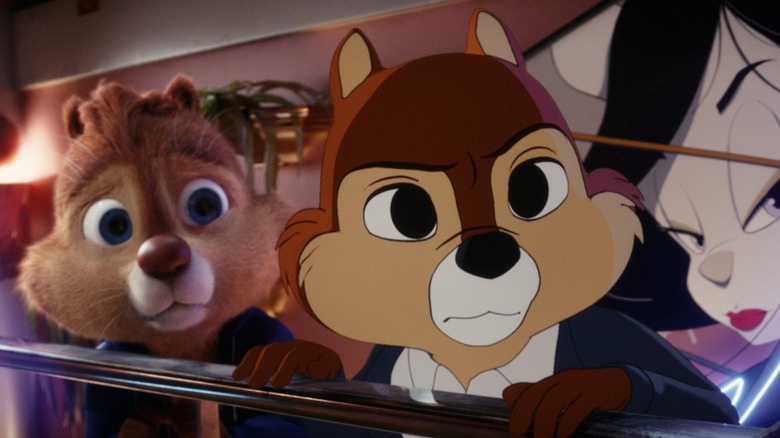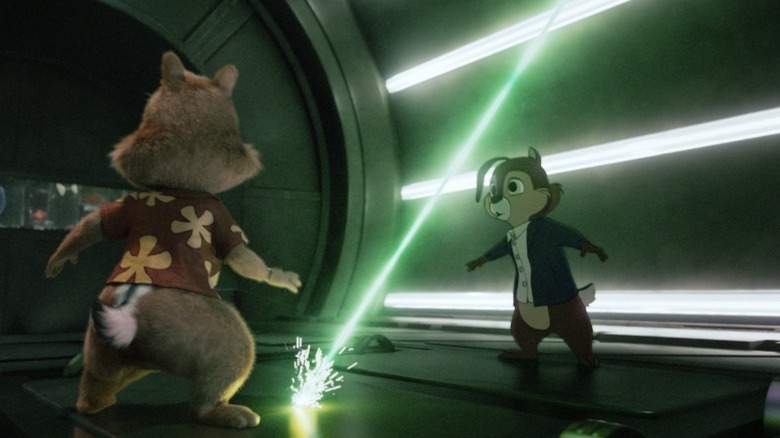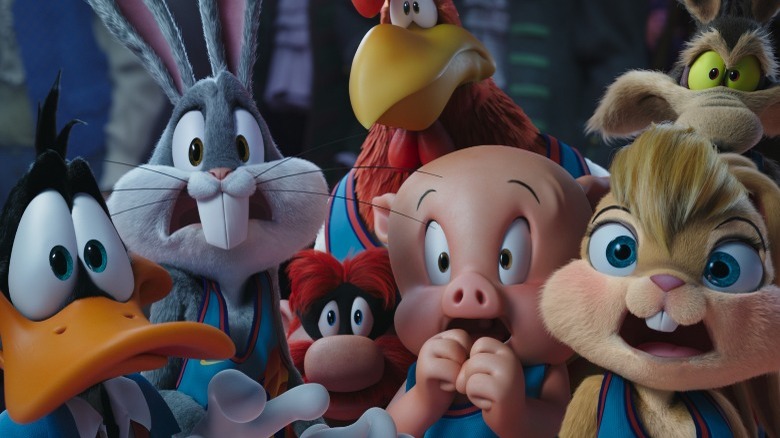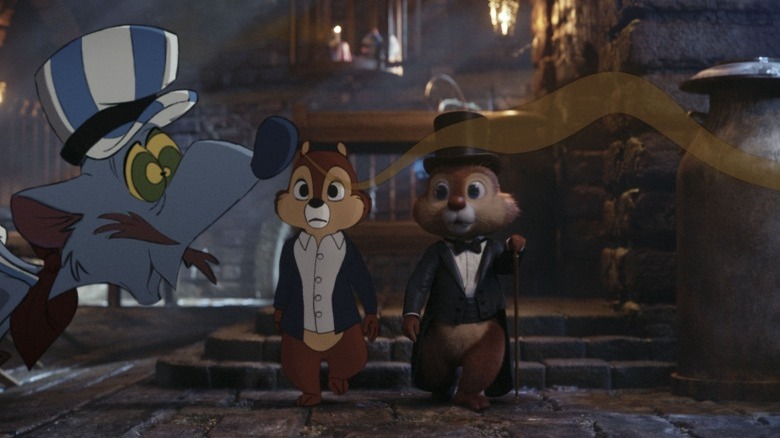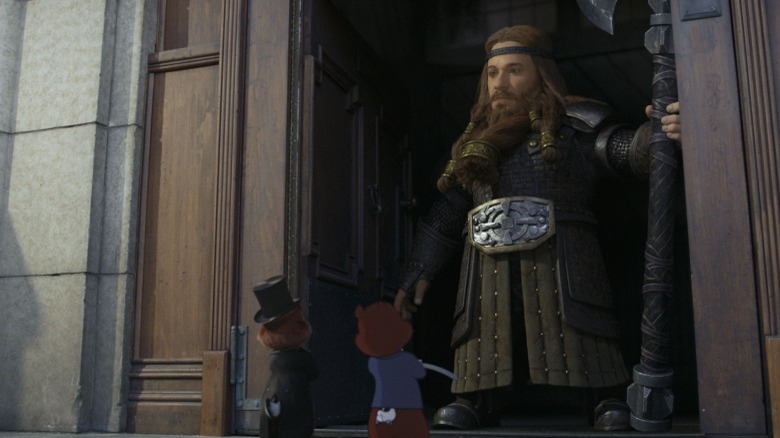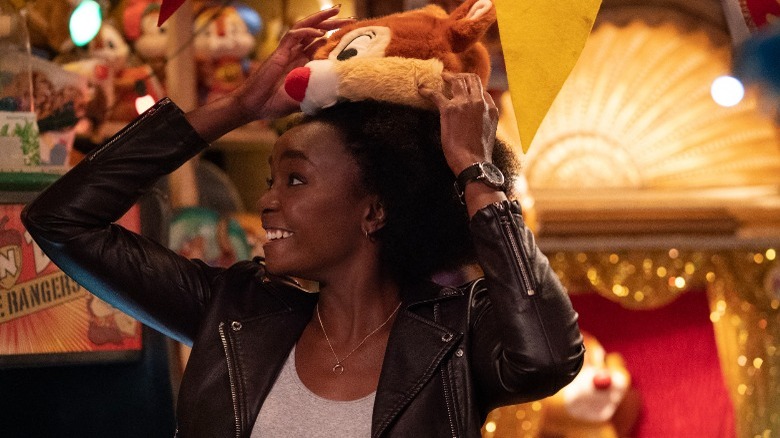Chip 'N Dale: Rescue Rangers Uses Nostalgia To Look To The Future
This post contains minor spoilers and story elements of "Chip 'n Dale: Rescue Rangers."
Are there any original ideas left in Hollywood? It's a question that's posed virtually every time a new remake, reboot, or sequel is announced. It's certainly one asked when it was revealed that Disney's beloved animated chipmunks were returning in the form of Akiva Schaffer's "Chip 'n Dale: Rescue Rangers." The film could have easily been a lazy cash-in, but it's anything but: it's hyperactive and zany, and it's full of moments that will make you wonder how on earth this film got made. What really makes "Rescue Rangers" stand out is the way it directly interrogates the very concept of original ideas in filmmaking.
"Rescue Rangers" catches up with Chip (John Mulaney) and Dale (Andy Samberg) in the present day, many years after their successful TV show in the early '90s. The pair are no longer speaking: Dale makes his living largely through appearances at fan conventions, while Chip works in insurance. In a terrific early scene, Dale (who's undergone "CG surgery" to give him an updated, 3D look) is at one of these conventions, surrounded by friends, including Ugly Sonic (Tim Robinson).
That's right, one of the characters in "Rescue Rangers" is the rejected early version of Sonic the Hedgehog that existed before the internet-led furor resulted in animators re-designing the character. It's ridiculous, but the decision to include Ugly Sonic is firmly in the "just crazy enough that it works" camp. While most films would use this cameo as a one-off joke, "Rescue Rangers" gives Ugly Sonic a purpose: he drives the plot forward instead of just being an opportunity to point at the screen like the Leonardo DiCaprio meme. The brilliant script, written by Dan Gregor and Doug Mand, gives the character motivations and a personality, refusing to confine him, or indeed any other cameo, to a throwaway moment.
Perfecting the balance
The plot of "Rescue Rangers" involves Chip and Dale reuniting many years after their beloved TV show to solve the disappearance of one of their dear friend Monterey Jack. There's a criminal group that kidnaps adored cartoon characters, changing their features just enough so bootleg versions of their classic films can be made. The organization is led by a cartoon — Sweet Pete, or rather a grown-up Peter Pan, still wearing his old costume. Furious with how he was cast aside after growing up, Pete fought back by making a bootleg version of his own film and sought to make his fortune by (forcibly) recruiting other cartoons to make more bootleg films. Not only does this lead to some hysterical visual cues (what I wouldn't give for a double-bill of "Jasper the Dead Ghost Kid" and "Spaghetti Dogs"), but it also provides a pointed critique of re-using and recycling other work to tell your own story.
"Rescue Rangers" will no doubt receive a lot of comparisons to "Who Framed Roger Rabbit," the most well-known, and best example of a film mixing live-action with animation. In order to really understand how impactful the film is, its most inviting comparison actually comes from the other recent big-budget animated live-action hybrid — "Space Jam: A New Legacy." Not only do both films operate in the same animation/live-action sphere, but both are also overflowing with cameos and references to other intellectual property. In fairness, it's difficult to find a new film or television show that doesn't in some way reference the past, as mining the idea of nostalgia has seemingly never been more popular. The big difference here, though, is execution.
Cashing in, grossing out
It's not just the cameos or references in these two films that matter, but rather how exactly these cameos are employed. Let's look at "A New Legacy" first. The plot echoes the original "Space Jam," swapping out basketball legend Michael Jordan with LeBron James. James (playing himself) must recruit a team of Looney Tunes alongside Bugs Bunny. To do so, they enter a number of different films, the most egregious of which is "Casablanca." That's right, in a 2021 film about cartoons playing basketball, there's a sequence that takes place right in Rick's Café, where piano player Sam has been replaced by Yosemite Sam. LeBron and Bugs hop in, take him back to their world, and ... that's it. That's the joke.
There's no rhyme or reason to the inclusion of "Casablanca" — it has no impact on the plot and is never brought up or referenced again. It feels especially hollow when compared to "Rescue Rangers." Every ridiculous cameo-led joke, from Flounder trying to stave off debt collectors with a dinglehopper to seeing Randy Marsh relaxing in a bathhouse, works. Why? Because of the world "Rescue Rangers" has created, we expect to see these characters, and the fact that they're all under threat adds a genuine level of urgency. The script practically trains us to keep our eyes peeled for cameo appearances, and each time we see a recognizable character, it only adds authenticity to the movie's surprisingly rich world.
Once more, with feeling
The most baffling and obvious example of "A New Legacy" exercising cameos without any reason except to distract your eye is the climactic basketball scene. The basketball court is surrounded by various characters from past films and television, including the Scooby-Doo gang, King Kong, Dorothy from "The Wizard of Oz," and ... the Droogs, from "A Clockwork Orange." It's here that this very idea of IP-flexing is most obvious: why in the world would the Droogs, a criminal gang that violently attacks and sexually assaults innocent people, be watching and vehemently cheering on this basketball game? It's a question that is never answered, and the moment feels not only confusing but genuinely icky. It all feels insidious, and "A New Legacy" has become the sort of poster child for nostalgia and IP-flexing gone horribly wrong.
Inversely, a moment in "Rescue Rangers" contains overwhelming visual information, but the purpose is entirely different. After barely escaping with their animated bodies intact, Chip and Dale come face to face with a wall of cartoon parts that have been taken from kidnapped cartoons. It's a lot of visual information to take in, as we're faced with a wall of various cartoon characters' accessories. Eagle-eyed viewers will spot things like Rocky's hat, Jimmy Neutron's hair, Sora's keyblade, and more. While the moment provides an opportunity to see how many references you can name, it's far more than visual fodder. It's a crucial story point that showcases the extent of Sweet Pete's operation, made all the more urgent by the discovery of Monterey Jack's mustache.
Chipmunks just wanna have fun
While "Rescue Rangers" does a lot of mocking — the literal existence of Ugly Sonic, a variety of memorable Disney sound cues pop up in absurd moments, and there's even Pooj, the Fat Honey Bear — it's lampooning feels like a genuine celebration of the world of animation. This is especially evident in the Uncanny Valley sequence. Chip and Dale arrive in a shady part of town where "everything looks strange." It's an area where all the early 2000s animated characters live, from films where "everything looked real, but nothing looked right" according to Chip. It leads to a hysterical interaction with Bob (Seth Rogen), a Viking who, because of his animation style, is never able to make eye contact.
It's silly, it's ridiculous, and it's meta, but it all serves a purpose: "Rescue Rangers" reminds us of its in-depth knowledge of all things animation, inviting us in on the joke. It's world-building for animation nerds, references steeped in actual knowledge of film history.
Nostalgia: a new hope
In a world increasingly obsessed with rebooting and relaunching everything studios can get their hands on, "Rescue Rangers" provides a blueprint on how rehashing old characters can actually provide a bold new direction for fandoms. The nostalgia on display in the movie is used as a way to challenge itself to tell a new and original story, adding complex new layers instead of simply relying on familiar faces to get by.
It's often hypercritical of itself — Dale comments on how there's nothing worse than cartoon characters rapping, only to be forced to rap later on — which allows the movie to deliver a thoughtful, original, and extremely funny experience. It's genuinely unbelievable that Disney approved a film like this, that makes such open mockery of so many of its characters. It's a movie rooted in nostalgia, but one deeply interested in moving past that nostalgia. As one character says: "I guess some things are worth rebooting."
